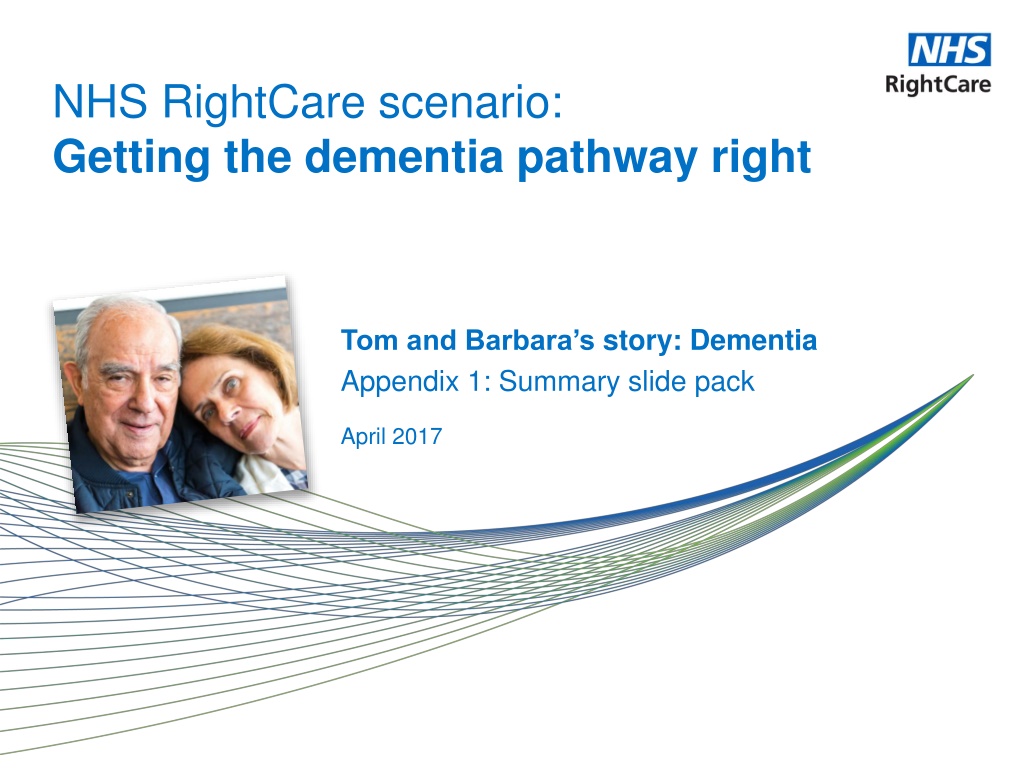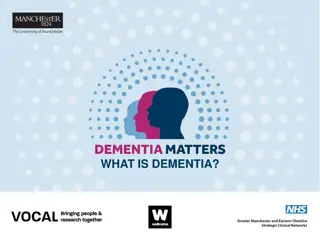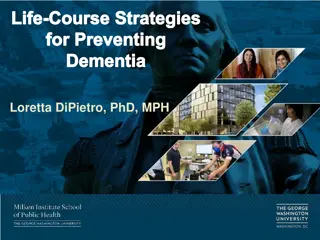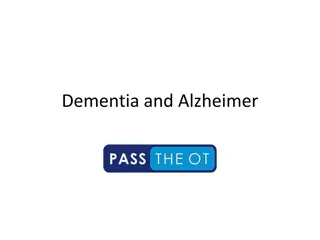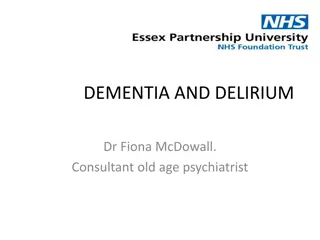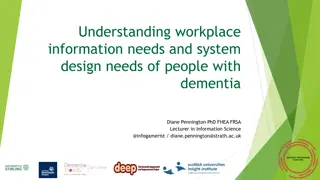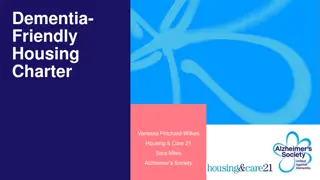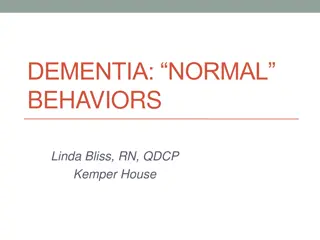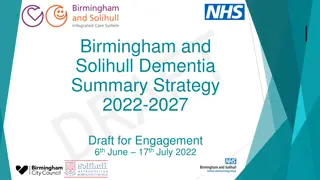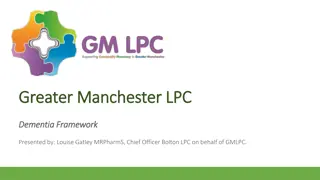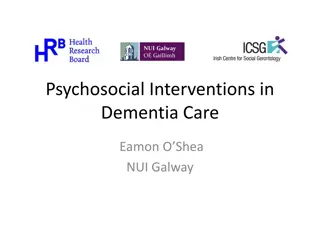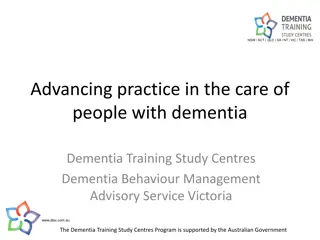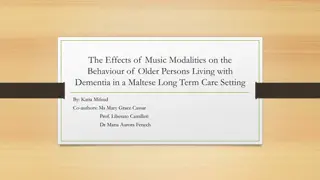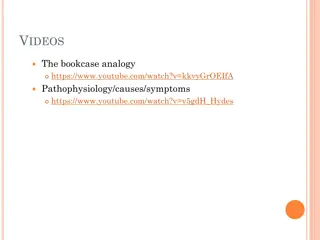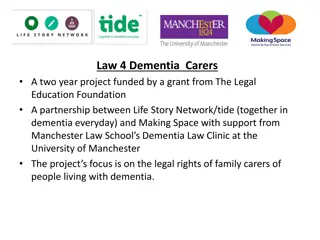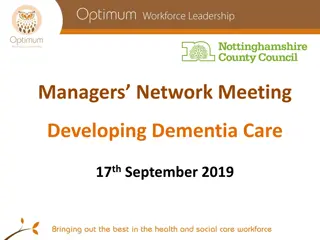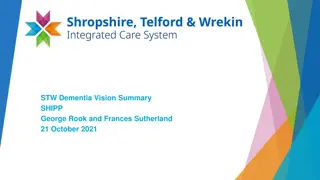Improving Dementia Care Pathways: Tom and Barbara's Story
An examination of a dementia care pathway through Tom's experience, comparing a sub-optimal scenario against an ideal pathway. Highlighting the importance of early intervention, proper support mechanisms, and the impact on both the individual and their family. Insights into the value of the NHS RightCare methodology in enhancing care outcomes and cost-effectiveness.
Uploaded on Oct 01, 2024 | 0 Views
Download Presentation

Please find below an Image/Link to download the presentation.
The content on the website is provided AS IS for your information and personal use only. It may not be sold, licensed, or shared on other websites without obtaining consent from the author. Download presentation by click this link. If you encounter any issues during the download, it is possible that the publisher has removed the file from their server.
E N D
Presentation Transcript
NHS RightCare scenario: Getting the dementia pathway right Tom and Barbara s story: Dementia Appendix 1: Summary slide pack April 2017
Toms story This is the story of Tom s experience of a dementia care pathway, and how it could have been so much better At each stage we have modelled the costs of care, both financial to the commissioner, and also the impact on the person and their family s outcomes and experience. In this scenario we examine a dementia care pathway, comparing a sub-optimal but typical scenario against an ideal pathway. 2 1 3 4 It shows how the NHS RightCare methodology can help clinicians and commissioners improve the value and outcomes of the care pathway. This document is intended to help commissioners and providers to understand the implications both in terms of quality of life and costs of shifting the care pathway 2
Tom and the sub-optimal pathway (1) Tom (a retired engineer) lives with his wife Barbara and is 77 years old when he first starts to experience symptoms Tom is reluctant to go to the GP.Barbara adjusts and keeps on keeping on, but tension is building (e.g. Tom was lost for several hours whilst walking) It is not until the fourth year (after symptoms started) that Tom becomes violent and entered the secondary care system He is admitted to hospital for five weeks; he is moved frequently and needs two security guards to keep him in bed. Barbara is not allowed to stay with him and can only visit during regular visiting hours. In a period of confusion, Tom falls out of bed and bruises his leg quite seriously Given Tom s deterioration it is now already too late for him to be able to grant Power Of Attorney In year 6, (aged 82) Tom is admitted to hospital again after significant confused episode and is found to have a severe infection from tooth decay Barbara is undertaking a super human effort and is increasingly isolated and exhausted By year 9, Tom is reluctant have help with feeding and this results in significant loss of weight and admission to hospital with pneumonia Tom is discharged to a care home where he dies after three months aged 85. 3
Tom and the sub-optimal pathway (2) No prevention Too late Pillar to post Traditional treatment Several wards Too much time in a secondary care bed. Reactive Limited education No third sector involvement Damage done Too much reliance on acute care Insufficient home care support for carer No risk profiling and identification Inappropriate acute care 4
Statistics Over a quarter of hospital beds in the UK are currently occupied by people with dementia One third of people with dementia who go into hospital for an unrelated condition NEVER return to their own homes 47% of people with dementia who go into hospital are physically less well when they leave than when they went in 54% of people with dementia who go into hospital are mentally less well when they leave than when they went in Alzheimer's Society 2009 report - Counting the Cost 10 days in a hospital bed (acute or community) leads to the equivalent of 10 years ageing in the muscles of people over 80 Gill et al (2004) studied the association between bedrest and functional decline over 18 months. They found a relationship between the amount of time spent in bed rest and the magnitude of functional decline in instrumental activities of daily living, mobility, physical activity and social activity. Kortebein P, Symons TB, Ferrando A et al. Functional impact of 10 days of bed rest in healthy older adults. J Gerontal A Biol Sci Med Sci. 2008;63:1076-1081 5
Questions for GPs and commissioners In the local population, who has overall responsibility for: 1 Promoting dementia as a condition for which targeted interventions (including prevention) must be planned and delivered? 2 3 4 5 6 7 8 Identifying individuals living with dementia? Planning care models to address key stages of dementia (pre/early, moderate or severe)? Identifying and reporting on measurable positive and negative dementia associated outcomes? Quality assurance and value for money in addressing the needs of those with dementia? Quality assurance and value for money of continence care? How do we do the right thing for the patient and at the same time recognise that costs shift from health to social care? Has any engagement activity taken place with patients with regards to dementia care?
Tom and the optimal pathway (1) Tom, aged 77, goes to his GP with Barbara who recommends he has a memory assessment with someone from the memory clinic Three weeks after seeing the GP Tom is assessed by someone from the memory clinic at the GP practice Tom is told he is likely to have dementia, but a brain scan will confirm this. Tom receives a diagnosis and is prescribed an acetylcholinesterase inhibitor. He is also introduced to the local dementia advisor. A care plan is developed that includes a series of local post diagnostic support activities In year 2, Tom sees his GP and it is considered that he most likely has a urinary tract infection and is prescribed antibiotics (avoiding secondary care) The Dementia advisor also offers high quality support (a lifeline to Barbara) including guidance around Power of Attorney Tom gets involved in lots of post diagnostic support groups including a walking group. Later he has a fall and is taken to A&E but it s only a bruise, good healthcare communication results in a very short stay Tom and Barbara maintain active lives together until year 8, with also Barbara receiving valuable respite In year 10, Tom is admitted to a care home as his needs can no longer be met in the home with Barbara as his primary carer. (10 good years together post diagnosis). 7
Tom and the optimal pathway (2) Prevention Focus Prevention focus Appropriate Fast Bespoke treatment Minimum time in bed / secondary care Greater understanding of need Support mechanisms in place Trusted system Happier and healthier experience Proactive Educational Third sector involvement Early risk awareness and identification Great acute care Great home care support 8
Financial information (1) Analysis by provider Sub-optimal Optimal Acute 17,428 600 Ambulance service 233 233 Care Home 7,670 7,670 Primary care 7,119 8,136 Third Sector 0 1,675 Grand total 32,450 18,315 Not only is Tom s (and his wife s) health and quality of life significantly better in the optimal scenario, but the costs to the health economy are reduced by 43%*. The impact is significant on outcomes, quality and finance. *Costs calculated as at 15/16 prices. 9
Financial information (2) Analysis by cost category Sub-optimal Optimal Primary care management 7,075 8,136 Urgent and Emergency Care 461 233 Secondary Care Management 17,200 600 Intermediate Care 7,670 7,670 Community Care 0 1,675 Grand total 32,450 18,315 This scenario is using a fictional patient, Tom. It is intended to help commissioners and providers understand the implications (both in terms of quality of life and financial costs) of shifting the dementia care pathway. Primary care expenditure is 15% more in the optimal scenario. Most of this investment is centred on: a) a dedicated dementia advisor ( 7.4k) and b) early diagnosis and earlier prescriptions for inhibitor drugs. The % increase is relatively small because there are significant cost savings associated with incontinence products ( 6.9k variance between the two scenarios). Secondary care expenditure is radically different, ranging from three hospital admissions totalling 43 days as an inpatient, compared to one day s stay in the optimal scenario ( 17k vs 1k) The third sector also makes a significant contribution in the optimal case with the provision of the singing for the brain programme ( 1.7k) 10
Further information For more information about Tom s journey, NHS RightCare or long term conditions you can: Email rightcare@nhs.net england.longtermconditions@nhs.net Visit https://www.england.nhs.uk/rightcare/ Tweet @NHSRightCare 12
